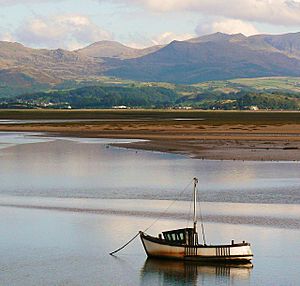Duddon Estuary facts for kids
Quick facts for kids
Designations
|
|
| Official name: Duddon Estuary | |
| Designated: | 16 March 1998 |
|---|---|
| Reference #: | 938 |
The Duddon Estuary is a special place where the River Duddon meets the sea. It has sandy and gritty shores. This estuary is located between Morecambe Bay and the coast of North Lonsdale.
The River Duddon and its estuary help form a natural border. This border is for the historic area known as Lancashire.
The estuary opens into the Irish Sea. It is just north of the Furness peninsula. Walney Island forms part of its southern edge. The Duddon Estuary has about 28 miles (45 km) of shoreline. It covers an area of 13 square miles (35 km2). This makes it the second largest estuary in Cumbria. Only the Solway Firth is bigger. It is also one of the six main estuaries in historic Lancashire.
Many towns and villages are found along the Duddon Estuary. These include Haverigg, Millom, Foxfield, Kirkby-in-Furness, Askam and Ireleth, and Barrow-in-Furness.
Contents
Why the Duddon Estuary is Special
The Duddon Estuary is very important for nature. In 1990, it was named a Site of Special Scientific Interest (SSSI). This happened when five smaller SSSIs were joined together. These included Duddon Sands, Sandscale Haws, North Walney, Hodbarrow Lagoon, and Haverigg Haws.
It is also a Ramsar site. This means it is a wetland of international importance.
Amazing Animals and Plants
The Duddon Estuary is a key home for natterjack toads. These rare amphibians are found in only about 50 places in the UK. The Duddon Estuary supports one-fifth of the entire UK population. Five of these important toad sites are within the estuary itself.
Birds of the Estuary
The Duddon Estuary is known as an Important Bird Area. Many different bird species can be seen here. You might spot pintail ducks, red knots, and common redshanks. In winter, many waterfowl visit. These include common shelducks, red-breasted mergansers, Eurasian oystercatchers, ringed plovers, dunlins, and Eurasian curlews.
In 1998, the estuary became a Special Protection Area (SPA). This was under the Birds Directive. It met three important requirements:
- Over 20,000 waterfowl regularly spend the winter here.
- It has a breeding population of sandwich terns.
- It supports large numbers of knot, pintail, and redshank in winter. It also has many ringed plover and sanderling birds passing through.
In 2016, there were talks about combining the Morecambe Bay and Duddon Estuary SPAs. This new larger area would also include marine areas. These areas are important for terns that breed in either SPA to find food.
Unique Plants
The estuary is rich in different types of plants. It has salt marshes, sand dunes, and shingle areas. There is a very rare shingle plant community at Haverigg Haws and North Walney.
Plants found on the shingle include sea sandwort, spear-leaved orache, sea rocket, and sea kale. The dune grasslands at Sandscale Haws, Haverigg Haws, and North Walney have many different plants. They are also home to the rare dune helleborine orchid.
Challenges for the Estuary
Building new structures has not greatly harmed the estuary's nature. However, some things could put it at risk. These include coastal defense work and farm animals grazing too much. Rising sea levels are also a concern. Too many people visiting or digging for bait can also cause problems.


